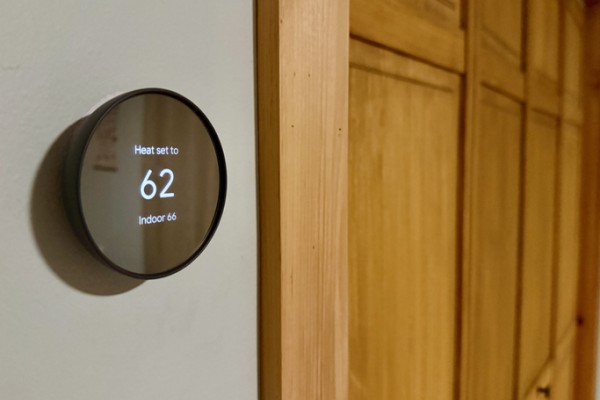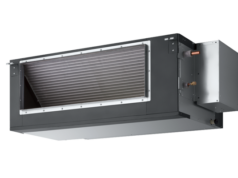
With growing pressure on household bills and the need to be conscious of our carbon footprint, smart thermostats can be seen as an essential addition for most family homes. But how can this device save you money while lowering emissions, and is it worth the investment?
What is a smart thermostat?
So, what exactly is a smart thermostat? While the explanation may seem straightforward, a lot of people do confuse this device with a smart meter, which serves a different purpose.
A smart thermostat allows you to control your heating remotely from your smartphone, tablet or smart speaker. Many can be fitted as a DIY task, and the thermostat allows precise and customisable operation of your central heating.
On the other hand, a smart meter simply provides you with your gas and/or electricity usage readings and is supplied and installed by your energy provider.
How does it work?
A smart thermostat works by connecting to your boiler and is then operated from an app on your smart device (typically a phone or tablet), but it can also be linked to your smart speaker. This makes adjusting your heating simple, efficient and convenient.
With a smart thermostat, you can carry out several functions remotely as long as you have an internet connection. The exact operations you have access to will depend on the specific make and model of smart thermostat, including:
- Altering the temperature of your home remotely to suit your needs and schedule.
- Multi-room control: Allowing you to heat different parts of your home independently using multiple thermostats or thermostatic radiator valves.
- Geofencing: Your smart thermostat detects when your smartphone or tablet leaves or enters the area and switches your heating on or off accordingly, or asks what you want to do.
- Learns your heating habits and how your home warms up and cools down. These models will begin to programme themselves within a couple of weeks based on your preferred temperature.
- Some thermostats let you control your hot water with an add-on, but typically only if you have a separate hot water tank.
- Draught detection is an option offered on some smart thermostats, which can alert you to a window being left open.
- Most models provide a holiday or safe mode that will turn on your heating if the temperature goes below a set limit. This helps to stop your pipes from freezing.
- Weather adaptation is available on some smart thermostats and allows them to adjust the settings based on the conditions outside.
- Gives feedback on how you are using your heating and offers tips on more energy-efficient practices
How does it save you money?
A smart thermostat saves you money by making your heating routine as efficient as possible. This includes only heating the house while you’re there, so that you’re not heating empty rooms, particularly if your schedule tends to be a bit hectic and you don’t have a regular routine.
Geofencing has a similar effect. You can programme your system to create a virtual boundary which detects when your smartphone enters or leaves the area, activating your heating to either switch on or off. This saves on waste and means you don’t have to remember to manually adjust your heating.
By learning your heating habits, your smart thermostat can automatically set the temperature, adjust it when necessary and make sure it comes on at the right times, according to your personal routine. This highly customised scheduling reduces the time when your heating needs to be on and lowers your heating bill.
Some smart thermostats track your energy usage, which can help you see where you can potentially make more savings.
Pros and cons of a smart thermostat
Before deciding whether to invest in a smart thermostat, it’s worth considering the pros and cons of these devices.
Pros:
- Save money by customising and personalising your heating to fit your schedule, even if you don’t have a regular routine.
- Remote access to your heating controls, regardless of where you are, as long as you have an internet connection.
- Geo-fencing means you don’t need to remember to switch your heating on or off, as it is automatically done for you.
- Self-learning thermostats build an algorithm based on how you like the heating to operate in your home.
- Movement sensors can detect if anyone is in the property, and if it’s empty, the heating will be switched off.
- Compatible with smart home systems, depending on the brand you choose
Cons:
- Many models require an extension kit and an internet bridge, specifically those that are not wired in but battery-operated
- Wired models will need to be fitted by a qualified person.
Cost of smart thermostats
A smart thermostat will cost between $160 and over $400. Price variations depend on the make and model that you want, with some offering basic features and others having additional functions.
Some thermostats form part of a wider smart home system, such as Hive or Nest, and are compatible with Amazon and Google smart devices, respectively.
What to look for in a smart thermostat
When considering whether or not to invest in a smart thermostat, the things to look for are:
- Compatibility with your type of boiler. Ensure it will work with your boiler type, e.g., combi, system, electric boiler, etc
- User interface: Is it easy to navigate and use?
- Features offered: Which features do you need for your lifestyle and home?
- Geofencing: Works with your smart device’s GPS system
- Self-learning capability: The thermostat will learn how you like the heating to operate, including your preferred temperature and schedule
- Smart home compatibility: Link to smart speakers and other smart home systems
- Energy reports: Track how you’re using your heating
- Multi-zone temperature regulation: Control which rooms are heated and when
- Weather adaptation: Checks the conditions outside to adjust the thermostat
- Movement sensors: Lack of movement can alert the thermostat to an empty house, and it will shut off the heating
- Draught detection: Detects an open window and will adjust the heating accordingly
Of course, every home is different, and your daily routine and household needs will determine which smart thermostat will best suit your lifestyle. However, these features will let you make the most of your smart thermostat and contribute to saving money on your energy bills.





